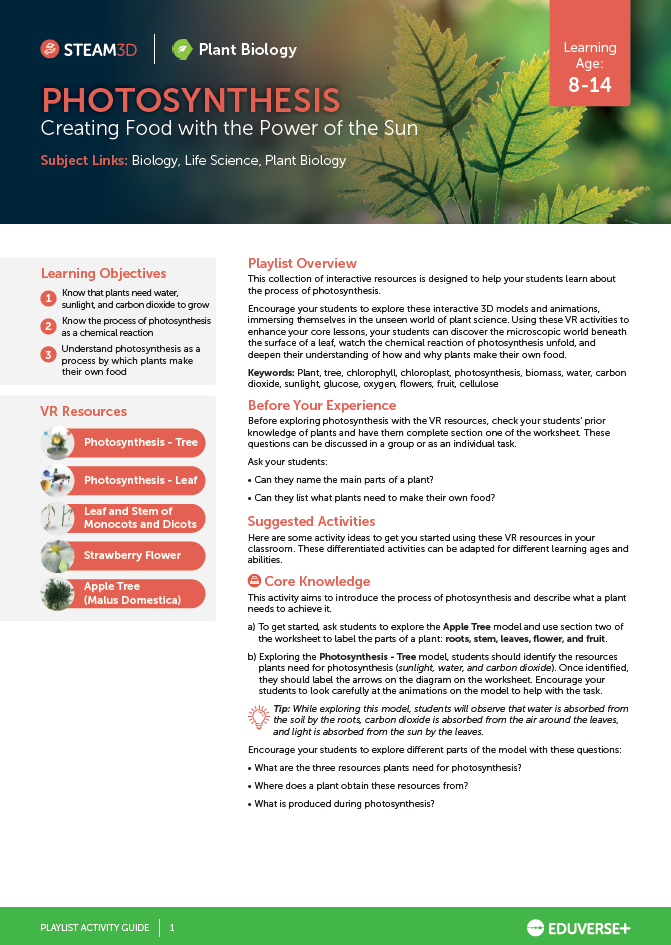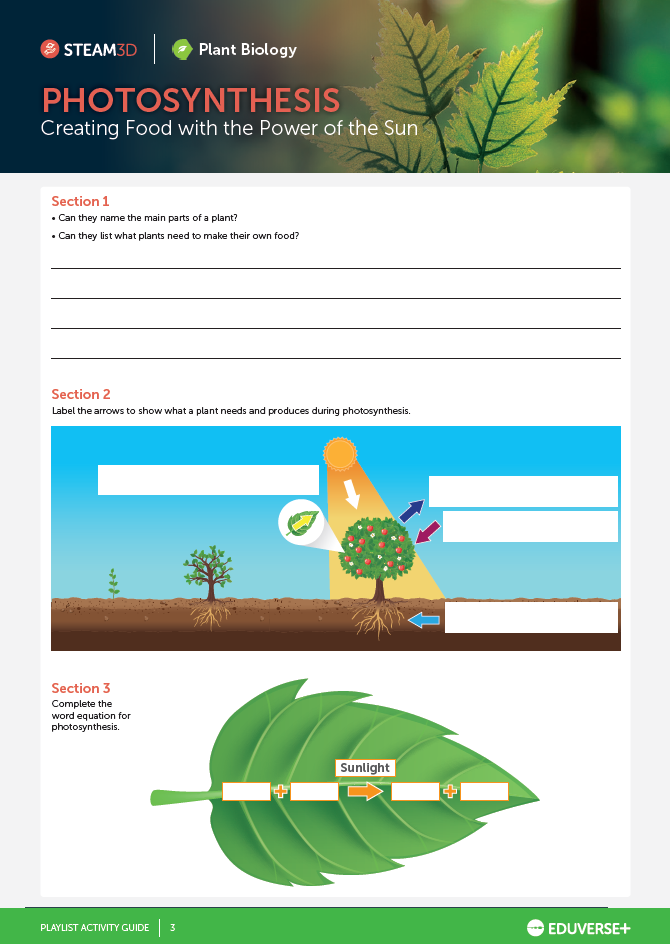 Loading...
Loading...
Initial language selection is based on your web browser preferences.
# PHOTOSYNTHESIS Creating Food with the Power of the Sun **Learning Age:** 8 - 14 **Subject Links:** Biology, Life Science, Plant Biology **Learning Objectives** *1. Know that plants need water, sunlight, and carbon dioxide to grow*{.info} *2. Know the process of photosynthesis as a chemical reaction*{.info} *3. Understand photosynthesis as a process by which plants make their own food*{.info} **Playlist Overview** This collection of interactive resources is designed to help your students learn about the process of photosynthesis. Encourage your students to explore these interactive 3D models and animations, immersing themselves in the unseen world of plant science. Using these VR activities to enhance your core lessons, your students can discover the microscopic world beneath the surface of a leaf, watch the chemical reaction of photosynthesis unfold, and deepen their understanding of how and why plants make their own food. **Keywords:** Plant, tree, chlorophyll, chloroplast, photosynthesis, biomass, water, carbon dioxide, sunlight, glucose, oxygen, flowers, fruit, cellulose **VR Resources** - **Photosynthesis - Tree** - **Photosynthesis - Leaf** - **Leaf and Stem of Monocots and Dicots** - **Strawberry - Flower** - **Apple Tree (Malus Domestica)** **Before Your Experience** Before exploring photosynthesis with the VR resources, check your students’ prior knowledge of plants and have them complete section one of the worksheet. These questions can be discussed in a group or as an individual task. Ask your students: - Can they name the main parts of a plant? - Can they list what plants need to make their own food? **Suggested Activities** Here are some activity ideas to get you started using these VR resources in your classroom. These differentiated activities can be adapted for different learning ages and abilities. # Core Knowledge{.objective .objective1} This activity aims to introduce the process of photosynthesis and describe what a plant needs to achieve it. a) To get started, ask students to explore the **Apple Tree** model and use section two of the worksheet to label the parts of a plant: *roots, stem, leaves, flower, and fruit.* b) Exploring the **Photosynthesis - Tree** model, students should identify the resources plants need for photosynthesis (*sunlight, water, and carbon dioxide*). Once identified, they should label the arrows on the diagram on the worksheet. Encourage your students to look carefully at the animations on the model to help with the task. *Tip: While exploring this model, students will observe that water is absorbed from the soil by the roots, carbon dioxide is absorbed from the air around the leaves, and light is absorbed from the sun by the leaves.* Encourage your students to explore different parts of the model with these questions: - What are the three resources plants need for photosynthesis? - Where does a plant obtain these resources from? - What is produced during photosynthesis? # Demonstrating Understanding{.objective .objective2} Challenge your students to represent the process of photosynthesis as a word equation. Section three of the worksheet includes a blank template where students can add the correct reactants and products to complete the word equation. The arrow represents "equals to". Use the **Photosynthesis - Leaf** model to help you complete this activity on the worksheet. *Tip: Students should observe the animated arrows on the model to determine that the reactants are water and carbon dioxide, that sunlight drives the process, and that oxygen and sugar (glucose) are the products.* Ask your students: - Can you identify the reactants? - Can you identify the products? *Word Equation: Water + Carbon Dioxide → Oxygen + Sugar* # Extended Learning{.objective .objective3} In this activity, ask your students to determine why plants generate their own food. They should use the following 3D models to identify the parts of the plant that rely on the energy produced by photosynthesis for growth and reproduction. This activity can be completed in section two of the worksheet. - **Leaf and Stem of Monocots and Dicots** - **Strawberry - Flower** - **Apple Tree (Malus Domestica)** *Tip: Students should identify that a plant needs energy to grow roots, leaves, flowers, fruits, seeds, and stem, and should note that some of these are used for reproduction.* Ask your students: - What other structural parts do plants produce during their lifetime? - What does a plant need to produce these different parts? - Can you describe the purposes of the different parts? **Cross-Curricular Links** **Art & Design** Ask students to create a 3D diorama of a deciduous tree to show photosynthesis taking place. They should add additional models to represent water, carbon dioxide, and sunlight. **English Language** Ask students to use the keywords and write a short story titled “In a Day’s Work for a Plant.” By using their knowledge of photosynthesis, they should write a short story from the point of view of a plant as it makes its own food to grow. **Geography** Ask students to research and create a profile of temperate biomes. The profile should include why deciduous plants grow well in these environments. # Activity Guide **Download the Activity Guide** [](https://avnfs.com/pZHQqUU5h2BDXER_zJdKuwR4iMmf9hvRxlCdVCrtxJo?size=953722&type=application%2Fpdf&name=Activity+Guide+-+Photosynthesis.pdf) # Student Worksheet **Download the Student Worksheet** [](https://avnfs.com/LKdVSNr_9Gv8N6G-hLm1aYWX4fT4Fzoo0L7tz-VAEU4?size=3581780&type=application%2Fpdf&name=Student+Worksheet+-+Photosynthesis.pdf)